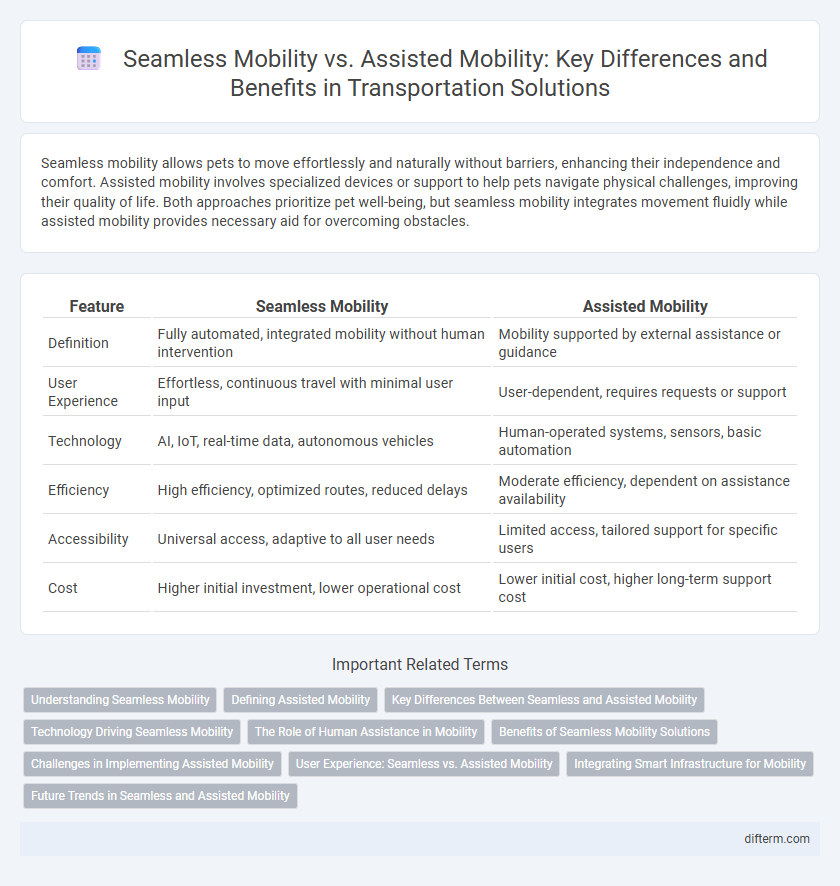Seamless mobility allows pets to move effortlessly and naturally without barriers, enhancing their independence and comfort. Assisted mobility involves specialized devices or support to help pets navigate physical challenges, improving their quality of life. Both approaches prioritize pet well-being, but seamless mobility integrates movement fluidly while assisted mobility provides necessary aid for overcoming obstacles.
Table of Comparison
| Feature | Seamless Mobility | Assisted Mobility |
|---|---|---|
| Definition | Fully automated, integrated mobility without human intervention | Mobility supported by external assistance or guidance |
| User Experience | Effortless, continuous travel with minimal user input | User-dependent, requires requests or support |
| Technology | AI, IoT, real-time data, autonomous vehicles | Human-operated systems, sensors, basic automation |
| Efficiency | High efficiency, optimized routes, reduced delays | Moderate efficiency, dependent on assistance availability |
| Accessibility | Universal access, adaptive to all user needs | Limited access, tailored support for specific users |
| Cost | Higher initial investment, lower operational cost | Lower initial cost, higher long-term support cost |
Understanding Seamless Mobility
Seamless mobility integrates multiple transportation modes into a unified system, providing users with uninterrupted, efficient travel experiences through real-time data synchronization and smart connectivity. Unlike assisted mobility, which relies on external support or guidance, seamless mobility emphasizes autonomous transitions and user empowerment, minimizing delays and maximizing convenience. Advanced technologies like AI-driven routing and IoT-enabled infrastructure are crucial in achieving truly seamless mobility ecosystems.
Defining Assisted Mobility
Assisted mobility refers to the use of supportive technologies or devices that enable individuals with mobility limitations to move more independently and safely. These solutions often include powered wheelchairs, mobility scooters, and robotic exoskeletons, which augment user capabilities. Unlike seamless mobility, which emphasizes uninterrupted and intuitive movement in various environments, assisted mobility centers on providing targeted help to overcome specific physical challenges.
Key Differences Between Seamless and Assisted Mobility
Seamless mobility offers uninterrupted and fully integrated travel experiences relying on autonomous technologies and real-time data, ensuring users transition effortlessly between transport modes. Assisted mobility involves human intervention or support systems to aid movement, such as guided navigation or mobility aids, enhancing accessibility but requiring active participation. Key differences include the level of automation, user independence, and integration with digital infrastructure, where seamless mobility emphasizes full system interoperability while assisted mobility prioritizes personalized assistance.
Technology Driving Seamless Mobility
Technology driving seamless mobility relies on real-time data integration, AI-powered navigation, and IoT connectivity to enable uninterrupted, efficient travel across diverse transportation modes. Advanced sensors, vehicle-to-everything (V2X) communication, and adaptive traffic management systems eliminate delays and optimize route planning. These innovations contrast with assisted mobility, which primarily supports user needs through partial automation and supplemental guidance rather than fully integrated, autonomous transport networks.
The Role of Human Assistance in Mobility
Seamless mobility emphasizes autonomous, uninterrupted movement through advanced technologies such as AI-driven navigation and real-time traffic data integration. Assisted mobility relies on human intervention, providing personalized support for individuals with disabilities or complex environments that require adaptive guidance. Human assistance enhances safety and accessibility by addressing unpredictable challenges that automation alone cannot fully anticipate.
Benefits of Seamless Mobility Solutions
Seamless mobility solutions enhance urban transportation by integrating various modes like buses, trains, and shared bikes into a single, user-friendly platform, reducing wait times and improving overall travel efficiency. These solutions leverage real-time data and advanced analytics to optimize route planning and minimize congestion, leading to lower carbon emissions and greater environmental sustainability. By providing intuitive access and payment options, seamless mobility increases convenience and accessibility, promoting higher adoption rates and fostering more inclusive, flexible travel experiences.
Challenges in Implementing Assisted Mobility
Implementing assisted mobility faces challenges such as integrating advanced sensor technologies and real-time data processing to ensure safety and reliability in diverse environments. Ensuring user accessibility while maintaining affordability creates significant barriers for widespread adoption. Compatibility with existing infrastructure and addressing regulatory compliance remain critical hurdles in scaling assisted mobility solutions.
User Experience: Seamless vs. Assisted Mobility
Seamless mobility delivers a frictionless user experience by integrating multiple transportation modes into a single, intuitive platform, reducing wait times and simplifying travel planning. Assisted mobility enhances accessibility for users with special needs or unfamiliar environments by providing real-time guidance and personalized support through AI-driven applications. Both approaches prioritize user convenience but differ in their level of automation and human interaction, addressing diverse mobility challenges.
Integrating Smart Infrastructure for Mobility
Integrating smart infrastructure enhances seamless mobility by enabling real-time data exchange between vehicles, traffic systems, and pedestrians, reducing congestion and improving route efficiency. Assisted mobility benefits from adaptive technologies such as intelligent traffic signals and connected sensors that support autonomous vehicles and mobility aids. Leveraging IoT and AI-driven analytics in smart infrastructure accelerates the transition from assisted to fully seamless mobility ecosystems.
Future Trends in Seamless and Assisted Mobility
Future trends in seamless and assisted mobility emphasize the integration of AI-powered systems and IoT to enable real-time, frictionless transportation experiences. Autonomous vehicles paired with advanced sensor networks are enhancing assisted mobility by improving safety and accessibility for diverse user groups. The convergence of 5G connectivity and machine learning algorithms is driving adaptive mobility solutions that anticipate user needs and optimize route efficiency.
seamless mobility vs assisted mobility Infographic

 difterm.com
difterm.com